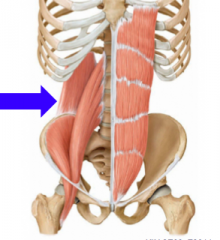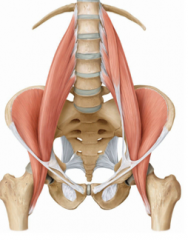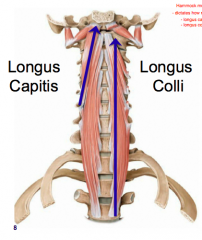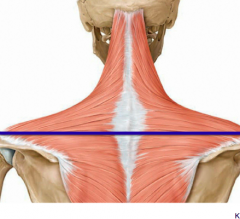![]()
![]()
![]()
Use LEFT and RIGHT arrow keys to navigate between flashcards;
Use UP and DOWN arrow keys to flip the card;
H to show hint;
A reads text to speech;
105 Cards in this Set
- Front
- Back
|
Joint between ilium and sacrum |
sacroiliac joint |
|
|
Sacral nutation |
flexion of the sacrum with respect to the ilium - proximal end moves anteriorly - distal end moves posteriorly
|
|
|
Why is the auricular surface of the sacrum rough? |
lots of stability and able to anchor |
|
|
Pelvis ring |
(2) sacroiliac joints (1) Symphysis pubis |
|
|
Sacrum |
wedge between the two ilia. - starts as 5 vertebrae but by age 30 becomes one solid sacrum |
|
|
Sacroiliac Ligaments |
1. Anterior 2. Interosseus 3. Posterior |
|
|
what is the main job of the sacroiliac joints |
stabalize |
|
|
Ligament that attaches at the posterior ischial tuberosity |
sacrotuberous |
|
|
Ligament that attaches at the spine of ischium from sacrom |
sacrospinous |
|
|
What do the sacrotuberous and sacrospinous ligaments do? |
stabilize and prevent posterior tilting of the pelvis |
|
|
Lordosis |
Over- extension of the vertebrae |
|
|
which way do the Superior articular process (SAP) face? what is a main job? |
face posterior and medial - blocks vertebrae on top from sliding forward |
|
|
which way does the IAP face? |
Anterior and lateral |
|
|
What does the ZA joint do? |
blocks rotation and translation therefore SAP and IAP fit together block rotation between the two segments |
|
|
Annulus fibrosis |
- tough layers - lots of collagen |
|
|
Nucleus pulposus |
- gel like core - bubble that shifts according to pressure
|
|
|
where are the annulus fibrosis and nucleus pulposus located? |
intervertebral disks |
|
|
Which ligaments of the spine limit extension and maintain normal curvature of the spine? |
Anterior Longitudinal ligament (ALL) Posterior longitudinal ligament (PLL)
|
|
|
Which spinal ligaments limit flexion? |
interspinous supraspinous ligamentum flavum
|
|
|
what does the iliolumbar ligament do? |
- holds L5 in place - responsible ligament for extensive lordosis |
|

Erector spinae |
- two columns of muscle that run the length of the spine
|
|
|
functions of erector spinae |
- extension of the spine - maintain upright position of spine - "cobra"
|
|
|
Unilateral contraction of erector spinae |
Ipsilateral flexion and rotation |
|

Multifidis |
- tent shaped muscles attach to transverse processes and the spinous process - 5 vertebrae length in total |
|
|
Actions of multifidis |
- extension - contralateral rotation
|
|

Quadratus Lumborum |
draws the ribcage down towards the iliac crest |
|
|
Actions of Quadratus Lumborum |
Ipsilateral flexion (side) - some extension when bilaterally contracted |
|

Psoas |
Anterior pillars along the spine - also helps move hip (flexion and external rotation |
|
|
Actions of the psoas |
flexion of lumbar (crunch)
|
|

External obliques |
muscles point down towards the midline of the pelvis |
|
|
Actions of external obliques |
- contralateral rotation - tilts pelvis posteriorly |
|

Internal Obliques |
starts at pelvis and goes up to the midline of the trunk |
|
|
Actions of internal obliques |
Ipsilateral rotation |
|

Tranvsverse abdominus |
run horizontally around almost the entire trunk - acts like a "belt" |
|
|
Function of transverse abdominus |
- spinal stabilizer - unilateral contraction= ipsilateral rotation (obliques are better rotators) |
|
|
actions of Rectus abdominus |
Trunk flexor tilts pelvis posteriorly |
|
|
Thoracolumbar fascia |
- envelops muscles of the spine - attachment of transverse abdominus and external obliques - also an attachment for 2 limb muscles (lats and gluts) |
|
|
C1 |
Atlas |
|
|
C2 |
Axis |
|
|
Atlanto- occipital joints (AO) |
- 2 joints - occipital condyles sit on top of the atlas - atlas hold skull "globe"
|
|
|
Actions of AO joint |
flexion= chin tucked into neck (double chin action) Extension= chin pokes forward (as if looking down your nose) |
|
|
Atlanto- Axial Joint (AA) |
- 3 joints - axis of rotation - dens out of axis and atlas rotates around it
|
|
|
Actions of AA joint |
rotation |
|
|
Transverse ligament of the atlas |
holds dens against the articular surface of the atlas
|
|
|
Lower cervical spine |
Flexion= head down towards the ground (chin down) Extension= face is parallel to the sky |
|
|
why is the cervical spine more mobile? |
because of the vestibular apparatus (balance system) therefore in order to observe the environment we need to be able to look around i order to balance |
|
|
Why are there foramens in the transverse process of the cervical vertebrae? |
allows passage of the vertebral artery to the brain |
|
|
Nuchal Ligament |
- attaches at EOP and spinous process of all cervical vertebrae - supports the back of the neck and limits flexion (what gravity wants therefore fights gravity)
|
|
|
Kyphosis |
opposite of lordosis; more "hunchback" |
|
|
Xiphoid process |
attachment for some abdominal muscles
|
|
|
true ribs |
1-7 |
|
|
false ribs |
8-10 |
|
|
floating ribs |
11 and 12 |
|
|
Motion of true ribs |
- water pump handle mechanism - obliques lift and lower (increase/ decrease dimensions of the ribs anteriorly and posteriorly) - expand and contract
|
|
|
motion of false ribs |
movement to the sides
|
|
|
why do the true ribs and false ribs have different motions? |
due to length of attached costal cartilage |
|

suboccipitals |
- exclusive to the cervical spine - headache muscles
1. oblique capitus superior 2. oblique capitus inferior 3. rectus capitus posterior minor 4. rectus capitus posterior major
|
|

Longus capitus and Longus Colli |
- hammock muscles - dictates how much lordosis there is in the cervical spine
|
|

Splenius capitis and cervicis |
- ipsilateral flexion
|
|

Levator scapula |
- affects the lower cervical spine - unilateral contraction= ispilateral flexion and rotation - bilateral contraction= extension of lower cervical spine - posture fixer (like reigns of a horse)
|
|

upper trapezius |
- off EOP and runs along nuchal ligament and down lateral portion of the clavicle - bilateral contraction= extensor of upper and lower clavicle - unilateral contraction= ipsilateral flexion - rotation= contralateral
|
|

Sternocleidomastoid |
flexion= lower cervical extension= upper cervical Unilateral= ipsilateral flexion Rotation= contralateral |
|

Scalenes |
all attach at the lower cervical and attach either at rib 1 or 2 and superior aspect |
|
|
Respiratory function of scalenes |
- accessory muscles for respiration |
|
|
Scalene role at cervical spine |
- ipsilateral flexion |
|
|
Scalene clinical relevance |
- inter- scalene triangle between the anterior and middle scalene allows nerves to pass through the space * Brachial plexus |
|
|
Purpose of intervertebral foramen |
Passage for spinal nerves |
|
|
How do you name the cervical, thoracic and lumbar vertebrae? |
cervical: nerve is named after the bottom vertebrae i.e C8 nerve= between C7 and T1
- every nerve after T1 is named after the vertebrae above it |
|
|
Plexus |
where multiple nerves join together |
|
|
what to plexi join? |
1. Lumbo- sacral plexus 2.Brachial plexus |
|
|
Femoral Nerve |

L2- L4 - innervates the psoas and illiacus - travels through the inguinal ligament to innerate the anterior compartment of the thigh - knee extension and hip flexion |
|
|
What is the femoral triangle? |
Inguinal ligament, Sartorius and adductor longus - femoral vein, femoral artery and femoral nerve pass through it |
|
|
Obturator Nerve |

L2- L4 - travels along the inside of the pelvis and through the obturator foraman, and though obturator canal - innervates the medial compartment of the hip - controls adduction |
|
|
Sciatic Nerve |

L4- S3 - very wide nerve (thumb width) --> functionallay two nerves stuck together - posterior aspect of the pelvis - sits right below the PIIS - associated with the piriformis --> innervates the posterior compartment of the thigh therfore knee flexion and hip extension
|
|
|
Polpiteal Fossa |
diamond shaped depression at the back of knee Top= Bicep femoris and 2 semis Bottom= two heads of gastrocnemius |
|
|
Tibial Nerve |

- travels along the back of the thigh - splits above the knee and travels through the popiteal fossa - innervates the back of leg; Plantar flexion
|
|
|
Fibular/ Peroneal Nerve |
- articulates the the fibular head - lateral side to the front of the leg - one branch= lateral compartment (fibularis); eversion - Deep nerve branch= anterior compartment; dorsiflexion
|
|
|
Apical and Alar ligaments |
- stabilize cervical spine - anchors dens to skull (C2) |
|
|
Iliolumbar ligament |
L5 transverse process --> iliac crest, postero- medial aspect |
|
|
Supraspinous |
Connects the tips of the spinous processes od adjacent vertebrae |
|
|
Interspinous |
Runs in between the spinous processes of the adjacent vertebrae |
|
|
Ligamentum Flavum |
Runs in spinal canal connecting the laminae of adjacent vertebrae |
|
|
Posterior Longitudinal Ligament |
vertebral bodies and intervertebral disks: posterior aspect within the spinal canal |
|
|
Anterior Longitudinal Ligament |
Vertebral bodies and intervertebral disks: anterior aspect |
|
|
Sacrotuberous |
Sacrum and coccyx: dorsal surfaces and lateral borders ---> ischial tuberosity |
|
|
Sacrospinous |
Sacrum and coccyx: lateral borders --> ischial spine |
|
|
costotranvserse ligament |
neck of rib and costal cartilage --> length of the transverse process of matching vertebraes |
|
|
Radiate Ligament |
circumference of the head of the rib --> body of the matching vertebra plus the vertebra above |
|
|
Nuchal Ligament |
EOP --> spinous process of all cervical vertebrae |
|
|
Transverse Ligament of axis |
Connects the lateral masses of C1 to one another, crossing the back of the dens |
|
|
Apical Ligament |
top of dens --> anterior margin of foramen magnum |
|
|
Alar Ligament |
Lateral surfaces of the dens --> margins of the foramen magnum, medial to occipital condyle |
|
|
Iliocostalis Lumborum |
Origin: sacrum, iliac crest, thorcaolumbar fascia
Insertion: ribs, transverse process of upper lumbar vertebrae |
|
|
Longissimus Thoracis |
Origin: sacrum, iliac crest, spinous process of lumbar spine
Insertion: transverse process of thoracic vertebrae, ribs, costal processes of lumbar vertebrae |
|
|
Splenius Cervicis |
origin: spinous process of thoracic vertebrae
insertion: transverse processes of c1 and c2 |
|
|
Multifidus |
origin: sacrum, ilium, Articular processes of Thoracic and cervical vertebrae
Insertion: spinous process of above vertebrae |
|
|
Longus capitis |
origin: Transverse process of cervical vertebrae
Insertion: occipital bone |
|
|
External obliques |
origin: ribs
Insertion: linea alba, iliac crest |
|
|
Internal Obliques |
Origin: iliac crest, ASIS, thoracolumbar fascia
Insertion: ribs, linea alba |
|
|
Transverse abdominus |
Origin: ASIS, costal cartilages, thoracolumbar fascia, inguinal ligament
Insertion: linea alba, pubic crest, rectus sheath (posterior) |
|
|
Rectus Abdominus |
Origin: xiphoid process, cartilages of ribs
Insertion: pubis |
|
|
Quadratus Lumborum |
origin: iliac crest
Insertion: 12 rib, transverse processes of lumbar spine |
|
|
Psoas Major |
Origin: vertebral bodies of lumbar and thoracic spine
Insertion: becomes illiacus and inserts on femur |
|
|
Sternocleidomastoid |
Origin: sternum and clavicle
Insertion: mastoid process
|
|
|
Scalene Anterior |
Origin: transverse process of cervical spine
Insertion: first rib |

